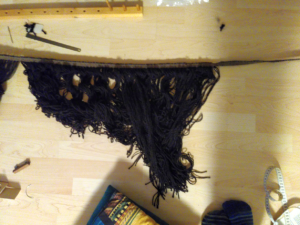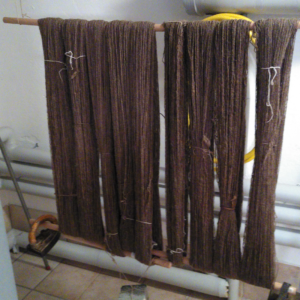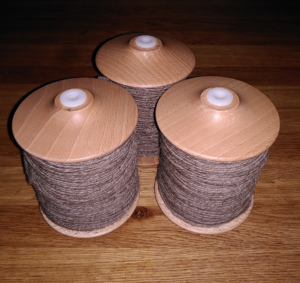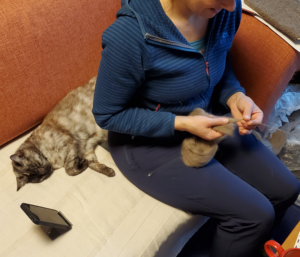Here's a fun fact on the Egtved corded skirt: These cords are thin. Really thin. And they are not fluffy at all, being twisted really hard.
The diameter of the individual, finished cords, consisting of four threads, is about 4 mm, often a little less - so a spun yarn thickness of a tad less than a mm was what I was going for. I did spin "normal twist" for my personal feeling, which is a rather firm yarn, but most of the final appearance is decided by the cording and the twist added then and there. (I tested that with the corded tassels on the belt, as there was a slight twist difference between the cut off warp yarns and the extra yarns inserted for the tassel.)
Here's a photo of the skirt in progress, with yarns and cords:
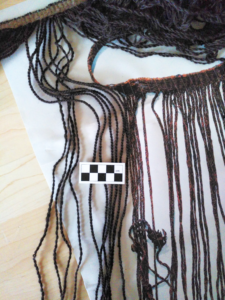
On the left, there's the sort-of-plied-up loops drawn through the band part while weaving. I used "fresh" yarn, so each loop plied up naturally quite a bit, resulting in a loose two-ply with a closed lower end. To the right of these, lying underneath the little scale gadget, you can see finished cords - and because the two-plied loops are a loose ply, and the finished four-element-cords are twisted very hard, they look only a little thicker than the two-ply loops.
To the right of those, there's the printout of the skirt in original size, for comparison. Like in the original, my cords vary slightly in thickness and twist density, but they are quite similar-looking overall. I do hope that this will not be affected a lot when giving the whole thing the finishing wet treatment. Though with the hard twist, I suspect there won't be a lot, if any, blooming/thickening of the cords. I do expect a bit of shrinkage of the whole band, bringing the cords a little closer together, perhaps. Things that keep those projects exciting!
The diameter of the individual, finished cords, consisting of four threads, is about 4 mm, often a little less - so a spun yarn thickness of a tad less than a mm was what I was going for. I did spin "normal twist" for my personal feeling, which is a rather firm yarn, but most of the final appearance is decided by the cording and the twist added then and there. (I tested that with the corded tassels on the belt, as there was a slight twist difference between the cut off warp yarns and the extra yarns inserted for the tassel.)
Here's a photo of the skirt in progress, with yarns and cords:

On the left, there's the sort-of-plied-up loops drawn through the band part while weaving. I used "fresh" yarn, so each loop plied up naturally quite a bit, resulting in a loose two-ply with a closed lower end. To the right of these, lying underneath the little scale gadget, you can see finished cords - and because the two-plied loops are a loose ply, and the finished four-element-cords are twisted very hard, they look only a little thicker than the two-ply loops.
To the right of those, there's the printout of the skirt in original size, for comparison. Like in the original, my cords vary slightly in thickness and twist density, but they are quite similar-looking overall. I do hope that this will not be affected a lot when giving the whole thing the finishing wet treatment. Though with the hard twist, I suspect there won't be a lot, if any, blooming/thickening of the cords. I do expect a bit of shrinkage of the whole band, bringing the cords a little closer together, perhaps. Things that keep those projects exciting!




